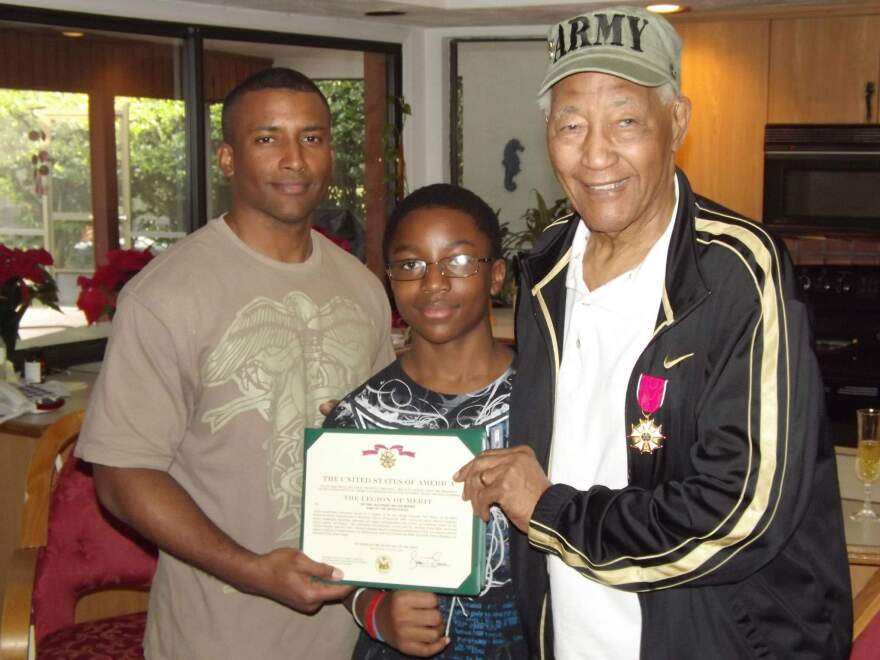Over 80 years ago, Walter Morris created the 555th Airborne Platoon, also known as the “Triple Nickles.” There is an exhibit about them at a museum on Fort Liberty - formerly known as Fort Bragg. There’s another exhibit at a Fayetteville Museum that will soon serve as one of 50 markers on the North Carolina Civil Rights Trail.
The journey of Walter Morris
In the winter of 1943, enlisted Black male soldiers in the were training as if they were parachutists. While Black men were not authorized to do that at the time, still led several men in the training.
At that moment, the Black man from Georgia did not know he would later lead the first Black paratrooper company in the U.S. Army.

“He was always looking to improve the circumstances of the people around. He was a leader,” said Morris’ grandson Michael Fowles, who currently serves in the Army as a Lieutenant Colonel.
Before the 555th Airborne Unit was created, Fowles said Morris trained to become an officer at in Fort Moore, formerly known as Fort Benning, Georgia. Although he did not complete the last week of school, the Army still saw his potential.
“Instead of flunking him out of the school and sending him back to the unit he came from, they wanted him to try again and come back to another class in the near future, at the Officer Candidate School,” said Fowles.
Forming the first all-Black airborne paratrooper platoon
Shortly after leaving the school, Fowles said Morris was still assigned to Fort Benning as support personnel for the airborne unit.
While serving there, Morris and other Black soldiers had to deal with unequal treatment on and off the base, including at px stores for military soldiers and their families.
“For example, Black soldiers were not allowed to use the main px on the installation, while prisoners of war were,” Fowles said.
Having to adhere to certain rules caused a lot of the Black soldiers to be discontent, but Fowles said that didn’t stop Morris from stepping up.
“He realized that the morale was low, because the soldiers weren't doing anything meaningful, other than caring for the grounds and equipment at the Airborne School,” he said.
Morris began instructing his soldiers to use the same facilities as the white soldiers did and use the same equipment after the white soldiers came off the field.
“This naturally built up the morale within the unit,” Fowles said.
One day, the Commanding General rode by and saw the Black soldiers training. Fowles said he met with Morris and told him he was impressed.
“He informed my grandfather that there's going to be a test platoon, this time as directed by the DoD (Department of Defense) through the Department of the Army,” said Fowles.
At the time, Morris was only a sergeant. But the commanding general promoted him to a First Sergeant and put him in charge of the test platoon. After that, Morris and his soldiers went through the training to get qualified to be paratroopers.
That group of men became known as the "Triple Nickles." The name was chosen as a tribute to the five cent nickel head of the Buffalo Soldiers, a unit of all-Black soldiers that first formed during the 19th century.
The history of the Triple Nickles
After several months of training, the company was moved to Camp Mackall just outside of Fort Liberty — formerly known as Fort Bragg — here in North Carolina.

They grew from a platoon of a few dozen soldiers to a company of about 400.
“The problem was the unit could never grow beyond the 400 black paratroopers it needed. So, it stayed in the United States,” said John Aarsen, the museum director for the .
He said in 1945, the Triple Nickles were instructed to go on a secret mission called, “Operation Firefly.” It was their only operation as a unit, since they were together for a short period of time. They went to the Pacific NorthWest to help fight forest fires from Japanese balloon bombs flying over the U.S.
“They also had to learn how to get out of that parachute, climb down the harness, climb down their reserve, and then climb down a rope to then fight the fire,” Aarsen said.
Those jumps Morris and the other Black soldiers did are now called “Smoke Jumps” and are officially a part of training for airborne soldiers today.
After completing the mission, they went back to Fort Liberty to be a part of the 82nd Airborne Division in 1946. It was deactivated a year later.

Some of the Triple Nickles members continued serving and others moved on with their lives as civilians. That includes Morris, who passed away about a decade ago. He was later honored with an award named after him. Until last year, it used to be given to the highest performing enlisted soldier in airborne school at Fort Moore.










